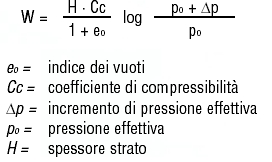
Effects of the wellpoint system on soils
The lowering of the groundwater as a result of pumping involves a variation in the actual pressures on the area. The pressure increase involves a settlement by consolidation with the effects of settlements that depend on the thickness of the layers, the compressibility, the lowering value and the duration of pumping. The settlements can be estimated with the relationship:

In order to correctly apply the previous relationship, it is necessary to obtain the compressibility and consolidation parameters from laboratory tests performed on undisturbed soil samples.
Based on the sensitivity of the soils to this phenomenon, we can distinguish them into:
– compressible soils, silts, clays, peat;
– poorly compressible soils, sands and gravels.
Sandy and gravelly soils are made up of solid particles of various shapes and sizes thickened together, leaving empty spaces between them that in saturated soils are filled with groundwater. During the operation of the wellpoint system, the interstices of the soil remain empty and the solid particles of the soil quickly reach a settlement situation. The effect of the consolidation on these lands and on the buildings affected by the radius of influence of the wellpoint system can be considered negligible. In compressible soils
The consolidation effect due to the lowering of the groundwater can cause subsidence of such an extent as to compromise the safety of nearby buildings and artifacts.
The value of the settlements, which is greatly important for design and calculate foundation structures, must not be neglected even when using wellpoint systems. To ensure safety, the system must not cause the removal of inert materials. Normally, the time of use of the wellpoint system is less than that necessary for the maturation of consolidation settlements. Moreover, the water extraction mainly concerns the land circumscribed by the system and only minimally the surrounding ones. On the other hand, in these soils, the system’s range of action is rather limited as it does not cause a “lowering” of the water table but only a “gravity interception” within the preferential paths constituted by the sand prefilters.

